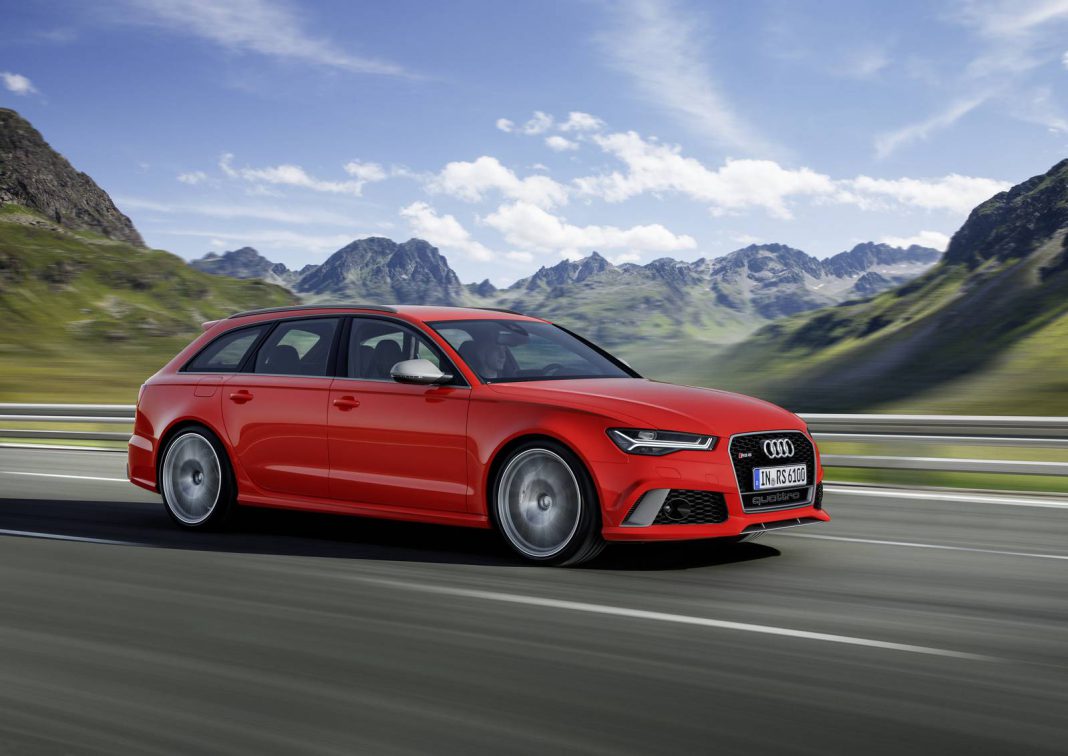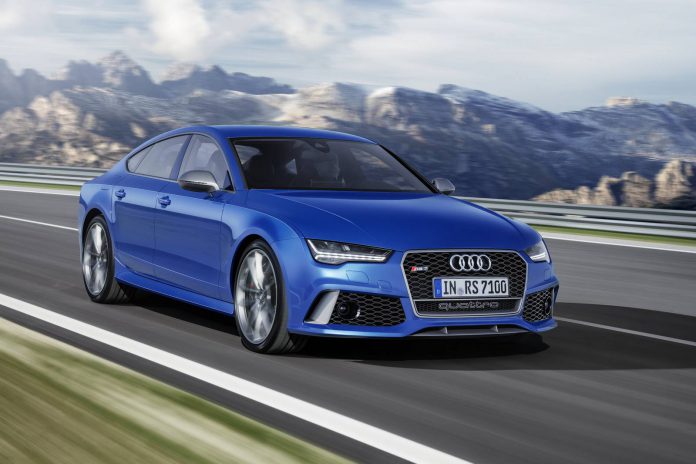For 2016, the Audi RS6 Performance and Audi RS7 Performance models have been added to the German company’s lineup. As the names of the cars hint, they offer slightly improved performance over the already potent RS6 and RS7s.
As both cars are powered by Audi’s twin-turbocharged 4.0-litre V8 engine, both benefit from the same performance improvements. Peak power from the boosted V8 has been increased from the standard 560 hp up to 605 hp with torque now sitting at 516 lb-ft and 553 lb-ft with the overboost function enabled. Thanks to the power and torque gains, the RS6 Performance and RS7 Performance now accelerate from 0-100 km/h in a mere 3.7 seconds compared to 3.9 seconds of the standard models.
Elsewhere, jut 12.1 seconds is needed to reach 200 km/h, 1.4 seconds less than standard and when the optional dynamic package is fitted, top speed rises to 305 km/h. Despite the potency of the twin-turbo V8, it consumes just 9.5-9.6 litres of fuel per 100 km.
Mated to both the RS6 Performance and RS7 Performance is an eight-speed transmission driving all four wheels. The driver has the D and S driving modes available at their fingertips and when manual mode is enabled, a shift indicator becomes operational in the gauge cluster or on the optional head-up display.
Elsewhere, both models feature modified adaptive air suspension which lowers the ride height of the duo by 20 mm. Owners can optional the stiffer RS sport suspension and Dynamic Ride Control system. Found standard on the RS6 Performance and RS7 Performance are new 21-inch cast aluminium wheels with 285 mm tyres on the RS6 and 285 mm tyres on the RS7. A carbon ceramic brake system is optional.
Inside, the two cars come complete with RS sport seats featuring prominent side bolsters and integrated head restraints. The seats have been newly upholstered with alcantara and leather in a honeycomb pattern.
[showhide]
“Even more performance coupled with outstanding efficiency – that is what is behind the new “performance” model designation at Audi. The Audi RS 6 Avant performance* and Audi RS 7 Sportback performance* further hone the brand’s sporty profile. Their 4.0 TFSI engine with 445 kW (605 hp) and up to 750 Nm (553.2 lb ft) of torque push acceleration (3.7 seconds) nearly to levels usually reserved for supercars. Fuel consumption remains unchanged at 9.6 and 9.5 liters per 100 kilometers (24.5 and 24.8 US mpg), respectively, corresponding to 223 and 221 g CO2 per km (358.9 and 355.7 g/mi). These are best-in-segment figures.
The new Audi RS 6 Avant performance and the new Audi RS 7 Sportback performance offer more power output than ever before. The 4.0 TFSI now produces 445 kW (605 hp) and maximum torque of 700 Nm (516.3 lb-ft). A particular highlight of the engine is an overboost function allowing the driver to temporarily draw on up to 750 Nm (553.2 lb-ft). The two RS high-performance models sprint like supercars from 0 to 100 km/h (62.1 mph) in just 3.7 seconds, an improvement of 0.2 seconds over the respective base RS model. They need just 12.1 seconds to accelerate from 0 to 200 km/h (124.3 mph), 1.4 seconds less than the base RS models. With the optional dynamic package, top speed can be increased from 250 to 280 and 305 km/h (155 to 174 and 189.5 mph), respectively. Despite the output boost of 33 kW (45 hp), the sonorous V8 biturbo power unit consumes just 9.6 and 9.5 liters of fuel per 100 kilometers (24.5 and 24.8 US mpg), respectively, corresponding to 223 and 221 g CO2(358.9 and 355.7 g/mi).
These top figures for power and efficiency are made possible by the technological expertise of Audi and quattro GmbH. Engineering skills and long years of experience with RS high-performance models went into further optimizing the 4.0 TFSI, from the specific engine management system with increased rpm and boost pressure to the Audi cylinder on demand (COD) system, which only activates four of the eight cylinders when under part load.
The standard eight-speed tiptronic has been designed for extreme sportiness in both the new RS 6 Avant performance and the new RS 7 Sportback performance. The driver can choose between the modes D and S or change gears manually either by tapping the selector lever or by using the shift paddles on the RS multifunction sport leather steering wheel. In manual mode, a shift indicator in the driver information system or optional head-up display indicates the rev limit.
quattro permanent all-wheel drive delivers the power to the road and flexibly distributes torque as needed via the center differential. In the standard configuration, 40 percent flows to the front axle and 60 percent to the rear axle. The wheel-selective torque control intervenes as necessary. Audi also equips the quattro drivetrain with an optional sport differential on the rear axle with active torque distribution between the inside and outside wheel.
With its dynamic setup, the standard RS adaptive air suspension lowers the body of the RS 6 Avant performance and RS 7 Sportback performance by 20 millimeters (0.8 in). The integrated damping control varies as a function of the road conditions, driving style and the mode chosen in Audi drive select. Audi offers the tauter RS sport suspension plus with Dynamic Ride Control (DRC) as an alternative. An additional option is dynamic steering with a continuously variable steering ratio.
The driver can adjust the function of key components using Audi drive select, including the steering, engine and sound management, the tiptronic and the optional sport differential. New in the performance models: Similar to the new Audi R8 high-performance sports car, the driver can switch between the modes auto, comfort, dynamic and individual without taking his or her eyes off the road using a special button on the RS multifunction sport leather steering wheel.
The new RS performance models come standard with exclusive 21‑inch cast aluminum wheels shod with size 285/30 tires on the RS 6 Avant performance and 275/30 tires on the RS 7 Sportback performance. The four internally ventilated brake disks have a weight-saving wave design; as an option, Audi offers carbon fiber-ceramic disks. Electronic Stabilization Control (ESC) has a Sport mode and can be deactivated if need be.
Striking design details reinforce the preeminent position of the two new RS performance models. These include the sportily designed bumpers with large air inlets up front and the heavily profiled diffuser insert at the rear, the gloss black honeycomb grille typical of the RS models and the flared side sills. The RS performance-specific exterior is distinguished by a quattro logo on the air inlet duct and add-on parts in matt titanium look. Audi offers the new exclusive paint finish Ascari blue, metallic as an option.
The sportily elegant interior of the RS 6 Avant performance and RS 7 Sportback performance comes standard with RS sport seats with pronounced side bolsters and integrated head restraints. Audi offers the seats in the color combination black and blue with the optional RS performance design package. This includes new seat upholstery in an Alcantara/leather combination with a honeycomb pattern and matching contrasting stitching on the armrests, control elements and floor mats. Rounding out this interior combination are knee pads in Alcantara and carbon twill blue inlays. This sophisticated and exclusive carbon material is interwoven with a blue thread. The dial instruments feature black faces, white dials and red needles.
The new Audi RS 6 Avant performance costs 117,000 euros in Germany; the new Audi RS 7 Sportback performance 121,700 euros. The two new models will be available at dealers beginning in November.
Fuel consumption of the models named above:
Audi RS 6 Avant performance:
Combined fuel consumption in l/100 km: 9.6 (24.5 US mpg);
Combined CO2 emissions in g/km: 223 (358.9 g/mi)
Audi RS 7 Sportback performance:
Combined fuel consumption in l/100 km: 9.5 (24.8 US mpg);
Combined CO2 emissions in g/km: 221 (355.7 g/mi)”
[/showhide]








































